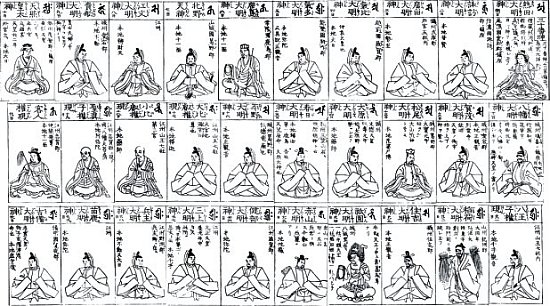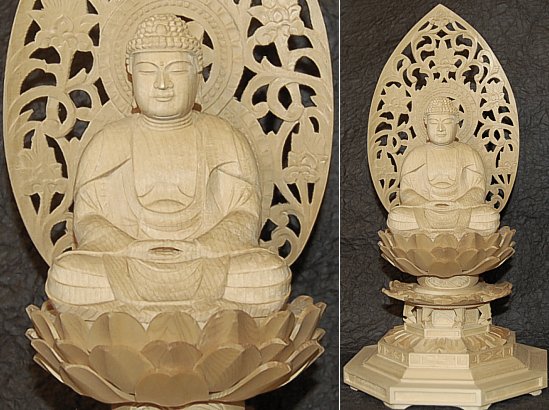Buddha Statues & Japan – May 2011
Hello Readers,
Knowledge and Product Updates for May 2011.
Updates to A-to-Z Dictionary of Japanese Deities
This month we dive deep into the heady waters of combinatory Buddha-Kami worship in Japan. For most of Japan’s recorded history, the myriad kami (local deities) were recognized as manifestations of the imported Buddhist divinities, and a great syncretic melding occurred, with temples and shrines sharing both deities and sacred grounds. This Buddha-Kami merger is known as Honji Suijaku 本地垂迹, the concept that local kami are manifestations (suijaku) of some higher universal deity (honji) and act as the local guardians of Buddhist doctrine. Alas, combinatory Buddhism-Shintoism was forcibly dismantled by the Japanese government in the Meiji Period (1868-1912), with Buddhism declared a superstitious foreign import of corruption and decadence. Buddhism’s dismantling was accompanied by the elevation of Shinto to state religion, with the emperor “turned living god” installed at the pinnacle of both political and religious power. Along the way, the architects of modern Japan fabricated a new history for the nation, one in which Shinto was portrayed as Japan’s ancient and indigenous religion.
» Sanjūbanshin 三十番神 (30 Kami Protectors of the 30 Days of the Month)
http://www.onmarkproductions.com/html/30-kami-of-the-month.html
These 30 kami are invoked to protect the peace and prosperity of the nation, its rulers, and its people, with each kami presiding over one day of the lunar 30-day month. These 30 kami are also considered guardians of the Lotus Sutra, protectors against curses, broken oaths, and the spirits of the dead. Each kami is linked to a Buddhist counterpart. The origin of this grouping is clouded in uncertainty. By tradition, it is said to have originated with Tendai monk Ennin 円仁 (794-864). <11 pages; photos of all 30 Kami and their Buddhist counterparts>
» Sanjūnichi Hibutsu 三十日秘仏 (Secret Buddhas of 30 Days of the Month)
http://www.onmarkproductions.com/html/30-hidden-butsu.html
The 30-kami grouping discussed above is a purely Japanese convention, one that originated with the combinatory Buddha-Kami practices of Japan’s Tendai sect. Nonetheless, its conceptual basis and development probably stems from earlier Chinese influences. Most scholars believe that a similar grouping, called the Secret Buddha of the 30 Days of the Month, originated in China around the 10th century, and then spread to Japan. This latter Chinese grouping may have sparked the development of Japan’s 30-kami set, but further research is needed to determine if the two sets are related. Although this 30-Buddha grouping is largely forgotten in modern Japan, it still serves today as the primary source for the ENNICHI (holy day, monthly memorial day) of Japan’s most beloved Buddhist divinities. Saying prayers to the deity on this day is believed to bring greater merits and results than on regular days. <5 pages; photos of all 30 deities>
Updates to Buddha Statue eStore
» ONE NEW PRODUCT ADDED TO OUR ESTORE
- Shaka Nyorai, the Historical Buddha (One New Product)
In The News & Current/Upcoming Exhibitions
» Disaster Relief for Japan. If you haven’t given yet, please consider donating (no matter how little). Visit the Friends of Japan Web Consortium – Donation Page for a list of trustworthy relief organizations.
» Osaka City Museum of Fine Arts, Until June 6th. Kuniyoshi: Spectacular Ukiyo-e Imagination. Around 400 woodblock prints (ukiyo-e) by famed artist Utagawa Kuniyoshi (1797-1861) are on display to celebrate the 150th anniversary since his death. See the Japanese web site (with great photos) or view a short Japan Times story.
» Buddhist monk in Japan raps to attract young converts (UPI.com). Includes a few quotes from Schumacher at the end of the article.
» Edo-Tokyo Musuem. April 29 through July 3, 2011. The Five Hundred Arhats by Kano Kazunobu (1816-63). Get the exhibit catalogue before viewing the artwork, as the catalog includes English descriptions while the gallery labels do not.
» Tokyo National Museum. April 26 through June 26, 2011. Buddha – The Story in Manga and Art. Buddha, a story in manga, was produced from a decade’s work by Tezuka Osamu, the iconic manga artist renowned for such popular series as Astro Boy and Kimba the White Lion. This exhibition is the first of its kind in Japan to show original manga illustrations alongside masterpieces of Buddhist sculpture.
» Kyoto National Museum. July 16 to August 28, 2011. Creatures’ Paradise: Animals in Art from the Kyoto National Museum.
» Nara National Museum. http://www.narahaku.go.jp/english/exhibition/special.html On to India! Xuanzang’s 30,000-Kilometer Trek. July 16 through August 28, 2011.
Secret Treasures & Sacred Image of Yoki Tenman Jinja: “The Hallowed Yoki Shrine at Hatsuse.” July 16 through August 28, 2011.
» Secrets of the Silk Road Exhibition. February 5 to June 5, 2011.
http://penn.museum/china-secrets-of-the-silk-road.html
Penn Museum (Philadelphia). Secrets of the Silk Road includes two mummies and the full burial trappings of a third, representative of three different periods of time. In addition to the mummies, the exhibition features more than 100 objects that offer insight into the long and diverse cultural heritage of Central Asia—a crossroads of the Silk Road.
» A Journey to Xiangtangshan. Feb. 26 through July 31, 2011. A clip from a video featured in the exhibition “Echoes of the Past: The Buddhist Cave Temples of Xiangtangshan,” on view at the Arthur M. Sackler Gallery, Smithsonian Institution.







